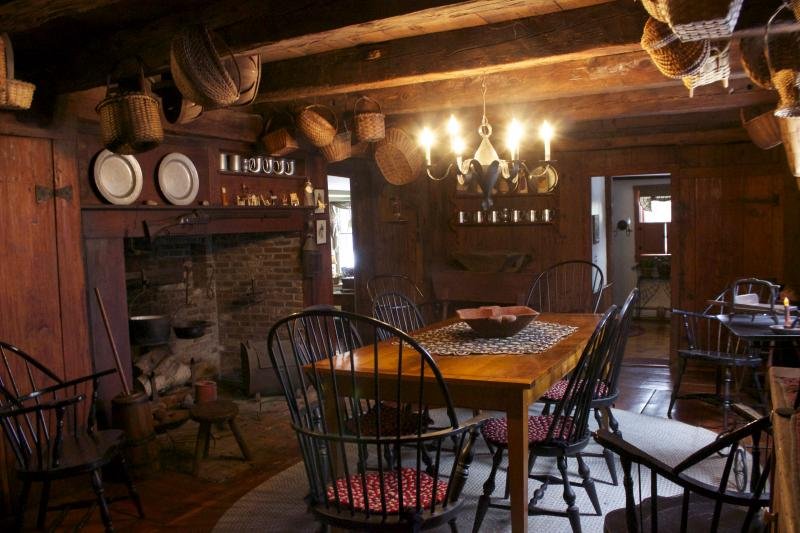Key Volunteer Skip Stuck guides volunteers through Great Neck Conservation Area during a January 2024 trail work day.
By Skip Stuck, Key Volunteer
In 2016, as a new Adopt-a-Preserve volunteer, I was introduced to Great Neck Conservation Area by Wildlands’ Director of Field Operations, Erik Boyer. I was immediately struck by the diversity and beauty of the place. But shortly after beginning our walk-through, we got lost, something we continued to do for the rest of the day. Even though Wildlands had owned the property for over 40 years, little had been done to develop a navigable trail system. Sure, there were trails, but a spaghetti hodgepodge of them. Neighbors had created many trails beginning at their property lines and ending God-knows-where. These trails ran up driveways, across private land, and within eyesight of homes and backyards.
It was quite a jigsaw puzzle. We contacted the New England Forestry Foundation and received permission to link our trails through their property. With Erik’s permission and support from neighbors (thank you, Butch!), we set out to remap the preserve, closing some trails and opening others to create a course that would allow visitors to enjoy all that Great Neck had to offer. Through trial by fire, I learned how to build and maintain eco-conscious trails. Several months and a lot of work later, the puzzle came together, and as access to its beauty opened, Great Neck came alive for me.
We hope it does for you, too.
One quick note: because Great Neck Conservation Area comprises several historically independent parcels, distilling the area’s disjointed recent history into a unified narrative proved difficult. Many more stories could be told than you will find here. If you or someone you know has information about Great Neck’s past, we would love to hear from you! Share your insight (and/or photos!) by emailing Communications Coordinator Thomas Patti at tpatti@wildlandstrust.org.
Native American Era
Glacial history is carved into the landscape of the Great Neck (AKA Indian Neck) region of Wareham. Drumlins, kettle ponds, glacial rocks, and sandy shoreline all had something to offer to Native Americans, who utilized the area's resources for thousands of years. The many arrowheads, tomahawks, and other artifacts found here attest to its popularity among Native peoples. The conservation area’s inlets, the Crooked River from the north and Mink Cove from the south, were used for shellfishing and fish weirs. The forested hillsides were used for hunting, and lowlands for farming.
In the early 1600s, the area was inhabited by the Nepinnae Ketit band, known to the English settlers as the Agawam Indians.
Colonial Era
The original sitting room in the 1683 Burgess House. By Bill Whelan for Wareham Week.
The English began to settle this area in the 1630s. In 1666, the Plymouth Colony bought an 8,000-acre tract of land known as the Agawam Purchase from the Native Americans. In 1682, Plymouth sold the property to seven settlers in the area that would become Wareham.
Some of Wareham's earliest English settlements were on Great Neck, including the Burgess House (circa 1680), the oldest house in Wareham.
1700s
English settlers cleared much of the land for agriculture, with the lowlands devoted to vegetables and the rocky glacial uplands converted to pastures for cattle and sheep. Swamps and bogs were logged for the stands of valuable white cedar trees that grew there. Salt hay was an important resource from the surrounding marshes. Iron and charcoal were mined from bogs and woodlands, all to be smelted in the several local mills.
1800s
The Crooked River that flowed through the property was dammed in at least two places, creating a tidal area, a freshwater marsh (Jack's Marsh) that was ultimately converted to a cranberry bog, and a freshwater pond (Swan Pond) to irrigate the bog.
In the later 19th century, though cranberries continued to be grown, the early English settlement began to give way to a summer community. In 1880, the Weld and Minot families began to acquire smaller parcels in the area.
1900s
By 1900, the Welds and Minots owned most of the property on Great Neck. Among other things, they developed their own golf course, now known as Little Harbor Golf Course, one of the first in the country.
In 1909, the independently owned cranberry bogs were consolidated to become the United Cranberry Company.
In 1920, parts of the Weld and Minot land were planted with red pine and Norway spruce in hopes of selling the timber. The red pine eventually died due to a root virus. However, the spruce did well and still grows wild on Great Neck.
Great Neck Conservation Area
In 1969, Grace Minot Peirce and John Wylde donated 53 acres of the property to The Nature Conservancy on the condition that they would only hold it until a local conservation group could assume responsibility. In 1975, the land was deeded to Wildlands Trust. The Saltonstall family donated their ~60-acre property northwest of Mink Cove to the New England Forestry Foundation (NEFF).
In 1979, Wildlands also took ownership of the 26-acre Mink Cove-Elkins property.
In the 1990s, NEFF approved Wildlands’ plans to build hiking trails through their property, thus completing a 4-mile trail system and linking all the properties.
Learn more:
To learn more about Great Neck’s human history, visit our conservation area to find evidence for yourself of its Indigenous, colonial, and agricultural past. Also, explore the resources we consulted for this piece:
Visit wildlandstrust.org/events to find a schedule of group hikes and volunteer opportunities at Great Neck and other Wildlands Trust preserves.
Read our property description: wildlandstrust.org/great-neck-conservation-area
"History of Wareham.” Town of Wareham website.
"A Resource Inventory and Management Plan for the Minot-Weld Conservancy and the Mink Cove-Elkins Reservation." Caroline Norden, Wildlands Trust, 1986.
“The Welds of Harvard Yard: History Through a Family Lens.” Craig Lambert in Harvard Magazine, 1998.












